Mourning the summer of 1862
150 years after a tragic conflict, a pilgrimage to the Minnesota River Valley yields facts but few answers.
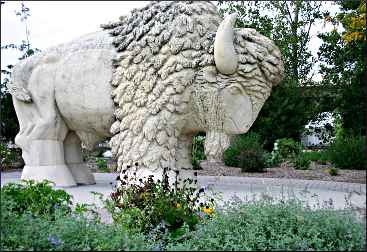
© Beth Gauper
In 1858, as Europe creaked under the weight of its impoverished masses, Minnesota was a place of opportunity.
It had plenty of land, and newcomers who worked hard could gain social standing as well as property, an impossibility in the old country. So the poor surged in, thankful for a future.
"When I consider my children, I think their futures will be very good, yes, much better than if I had stayed in Norway," my great-great-grandfather Rolf wrote home after his arrival in 1862.
America was a boon to my ancestors, who were wretchedly poor in their native lands. There was just one snag: Someone else already lived here.
They were the Dakota and Ojibwe, for whom this also was the land of the free and had been for many generations. They, too, made their living off the land.
The Dakota lived around the fertile Minnesota River Valley, which settlers coveted for farmland. Some squatted on the land, but most settled legally, and in general, they coexisted peacefully with their Dakota neighbors.
Until 1862, when the neighbors showed up at their doors with guns and knives.
Build-up to war
The Sioux Uprising, as it was called, sent shock waves throughout the frontier. For newcomers, it was a thunderbolt from the blue, but others were not so surprised.
It was no secret that traders claimed nearly all of the Dakota's annual treaty payments, much of it fraudulently. Preferential treatment of farmer Indians and mixed-bloods over the families of traditional hunters had divided the tightly knit community.
A revolving cast of political appointees managed the Dakota with callous indifference — in the summer of 1862, when their annual payment was delayed, a new agent refused to release provisions to the hungry Dakota until the cash also arrived.
Rapidly losing respect for whites, tired of being treated like children and disgusted by the disintegration of their culture, a few young Dakota hunters pulled the whole nation into war.
In a short-lived but grisly spurt of violence, they killed as many as 500 civilians, many of them women and children, yet spared whites who had been friendly.
In the end, a Minnesota military commission made little distinction between Dakota instigators and those who were forced to participate, condemning 303 men to death.
President Lincoln reduced the number to 39, and on Dec. 26, 38 men — the largest mass execution in our nation's history — were hanged in Mankato.
That winter, 1,658 Dakota, many of them women and children, were imprisoned at Fort Snelling, where at least 130 died. The survivors were shipped to barren lands in South Dakota, where more died, and then were sent, three years later, to a reservation in Nebraska.
The once-proud nation was broken.

© Beth Gauper
No easy answers
There's nothing easy about the U.S.-Dakota War of 1862, as whites and Indians alike struggle to deal with its legacy.
"It's a really complex, messy story," says Ben Leonard, director of the Nicollet County Historical Society, which operates Fort Ridgely. "It's not just 'The Indians and whites came together for a treaty, America screwed the Indians, they had a war and America won.' "
Eventually, the Dakota trickled back into Minnesota, and the U.S. government provided small reservations, including two in the Minnesota River Valley. Only 1.2 percent of the state's population today is Indian, and to many, they're invisible.
"When I ask kindergartners or first-graders if American Indians are living today, they'll say, 'Oh no, they're gone, they all got killed by cowboys,' " Leonard says.
"We have a really important charge when interpreting these sites, because people are not learning it in school. There's a huge ignorance, not just about Dakota history but about the Dakota presence, too."
The history I learned in school was meant to be inspirational, so it was all about the intrepid European explorers and the hardy pioneers, many of whom actually were well-educated entrepreneurs and speculators from the East.
No one taught me what Leonard calls "the icky history." But every branch of my family — Norwegians, Swedes, Germans and Scots — settled on what once was Dakota or Ho-Chunk land. I owe it to the indigenous people to learn.
Following Joseph Brown
I start in Henderson, where there is a rare monument to a Dakota man — John Otherday, a Christian farmer who helped 62 whites to safety in 1862. With his $2,500 reward, he bought a farm near Henderson.
But it failed, and he died on a South Dakota reservation.
It was hard for the Dakota to get ahead. They had to navigate a foreign, often hostile culture, and the federal payments and incentives meant for them ended up financing frontier development and enriching traders.
One of those traders was Joseph Renshaw Brown, an inventive opportunist whose fingerprints are found throughout early Minnesota history.
Brown founded Henderson, and its Joseph R. Brown Minnesota River Center includes a Dakota War exhibit that asks whether tragedy could have been averted if, for example, a proposed Northwestern Indian Territory had not been rejected by the U.S. Senate in 1842.
The voices of those who have studied the era carry a hard edge.
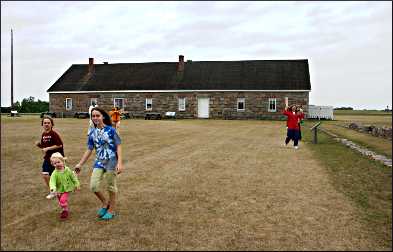
© Beth Gauper
"It takes impossible naivete to believe that promises would have been kept and the integrity of such a territory preserved," writes historian Rhoda Gilman, as quoted in the exhibit.
"It might have bought enough time for the Dakota . . . to adjust to the inevitable loss of their homeland and find a means to resist short of violent self-destruction."
I feel a sinking in my stomach, a queasiness that will stay with me as I trace the history of this war. There are no good guys and no triumphs in this story.
On the road to Fort Ridgely
After the 1851 Treaty of Traverse des Sioux opened the western part of the state to settlement, Joseph Brown built a road from Henderson to Fort Ridgely and became purveyor to the frontier.
Fort Ridgely, which was attacked on the third day of the war, was more post than fort, without a stockade or even a well. But it had fearsome artillery, and the soldiers and refugees inside were able to defend it until troops from Fort Snelling arrived.
In one of the tragic ironies that run throughout the conflict, the Dakota's gold had just arrived, two months late.
Today, the old commissary is a visitors center, which tells the story with exhibits and a movie. Outside, tourists wander among the ruins of the fort, and I met Christine Hazlett, whose home in Pennsylvania is near Civil War battlefields.
She said she could understand the pain that lingers more than 150 years after the war.
"We have that between North and South back at home," she said.
"Sometimes I think, 'Gee, get on with it, forget about it,' " said her daughter, Julie. "But I guess it's brought down from generation to generation."
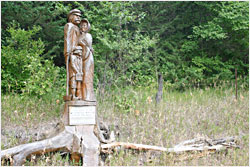
© Beth Gauper
Attack at Lower Sioux Agency
The Lower Sioux Agency is not far upstream. The Dakota attacked first here, where traders had cut off credit; the body of Andrew Myrick, who had remarked, "If they are hungry, let them eat grass," was found with the mouth stuffed with grass.
Today, captivating Minnesota Historical Society exhibits follow the Dakota's story from the fur trade to the War of 1862 and beyond, to their forced acculturation at the hands of bureaucrats.
Marcia and Scott Hippen of Chanhassen, Minn., had brought their six children, and it was easy for them to draw parallels their children could understand.
"How would we feel if the Somalis, for example, came here and made us wear cloths on our heads and eat their food?" Marcia Hippen asked. "We'd be lost."
Ruins in a lush valley
The isolated gravel road that winds west from the Lower Sioux hugs the broad, lush river plain. Overhead, rays of sun stream out of a bank of clouds and bathe the valley in light.
It looks God-given — but to whom?
The Dakota believed the Earth was for all living things to share. The Europeans believed it could be privately owned.
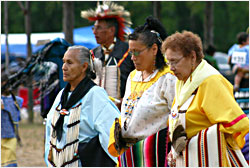
© Beth Gauper
At the entrance to a tidy farmhouse, I stop to read a memorial to seven German settlers killed by the Dakota: "Erected by State of Minnesota, 1915, in memory of martyrs for civilization."
Not far away, I see a wooden statue "dedicated to the pioneers who settled this valley."
And soon I reach the ruins of Joseph Brown's 19-room rose-granite home, known as the Farther and Gay Castle, built soon after he'd left his lucrative post as Indian agent.
After the war started, Dakota warriors, whose food and annuity payments Brown had diverted to those who agreed to farm, were quick to burn it.
Where the 'good' Indians lived
Across the river, Terri Dinesen managed Upper Sioux Agency State Park for more than two decades.
"I'm very much on the Dakota side of things," she said. "What if you and I had our families put on a farm, and they didn't have sufficient food and the game was gone, and you got so frustrated that the U.S. government didn't hold up one single treaty promise made to the Dakota people? We wouldn't stand for it, not when we see our people's way of life dying."
Many of the Dakota who lived around Upper Sioux Agency were farmers, derisively called "cut-hairs" by those who did not want to abandon their traditional lifestyle.
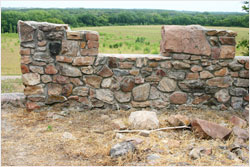
© Beth Gauper
They were among the many Dakota who helped settlers escape during the 1862 war, but they too were banished.
I spent much of the weekend at their traditional wacipi, or powwow. watching the dancers and listening to drums. Before I went home, I stopped to say goodbye to Dinesen.
As we chatted, I leafed through a book by Curtis Dahlin, "Dakota Uprising Victims, Gravestones & Stories." The accounts of violence against settlers are graphic.
"After I read it, I was mad," Dinesen admitted. "You get really torn when you start looking into this story."
No, it's not a pretty story. Unfortunately, it's all ours.
Trip Tips: Learning about the U.S.-Dakota War of 1862
Background: The Minnesota Historical Society maintains a website about the events of 1862.
Many books about the war are available at the Minnesota History Center and from the Minnesota Historical Society Press, including " The Dakota War of 1862" by Kenneth Carley.
For more about Indians in Minnesota, see Ojibwe or Chippewa, Dakota or Sioux? and Heritage travel: Dakota and Ojibwe.
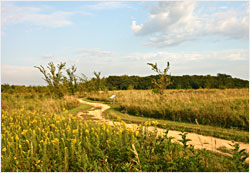
© Beth Gauper
Planning a trip: Here's a handy map of the Minnesota River Valley Scenic Byway.
For information on the towns and attractions on the Upper Minnesota River, call Prairie Waters tourism, 866-866-5432.
Touring: A mobile-phone tour provides stories and reflections at stops along the route.
The history trail from east to west
All sites are along the Minnesota River. Henderson is an hour southwest of Minneapolis; Montevideo is 2½ hours west.
For more details about the area and the war, see River with a past.
Joseph R. Brown Minnesota River Center in Henderson. Brown — fur trader, political operative, Indian agent, newspaper editor, inventor — played an important role in the conflict. He was fluent in Dakota and was married to three part-Dakota women, but it's hard to tell if he was friend or foe.
Treaty Site History Center in St. Peter. This center on the north edge of St. Peter, off U.S. 169, contains copies of the "trader's papers" that allowed white men to siphon off virtually all the money the Dakota received under 1851 and 1858 treaties.
Mankato: The site of the 1862 hanging is marked at Reconciliation Park, off Riverfront Drive, by a white limestone buffalo.
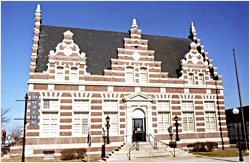
© Beth Gauper
New Ulm: Barricaded settlers in this heavily German town withstood a siege, though most of the town was burned. The Brown County Historical Society museum includes a U.S.-Dakota War of 1862 exhibit.
Fort Ridgely near Fairfax. There are exhibits in the restored commissary and interpretive markers on the grounds, which include the stone foundations of fort buildings. It's in Fort Ridgely State Park, seven miles south of Fairfax off Minnesota 4.
Lower Sioux Agency near Morton. This site, managed by the Lower Sioux Indian Community, was the first place attacked during the 1862 war.
It has an illuminating museum and an 1861 stone warehouse that is the only original building remaining. It's nine miles east of Redwood Falls.
Birch Coulee Battlefield near Morton. This beautiful restored prairie is where Dakota warriors surprised a burial party sent from Fort Ridgely, in a battle that became the biggest setback for U.S. troops in the 1862 conflict.
Self-guided trails and displays explain events. It's three miles north of Morton at the junction of county roads 2 and 18, one mile east of U.S. 71.
Joseph R. Brown ruins between Redwood Falls and Granite Falls. This state wayside is along County Road 15 on the north side of the river.
Upper Sioux Agency State Park near Granite Falls. Interpretive markers tell the site's history, and two tipis can be rented for overnight stays. It's eight miles southeast of Granite Falls.
Wood Lake Battlefield near Granite Falls. The final battle was held just south of the Upper Sioux Agency on County Road 18, just west of Minnesota 67. There's a monument.
Camp Release near Montevideo. On Sept. 26, 1862, Col. Henry Hastings Sibley received 269 captives from the Dakota and took into custody 1,200 Dakota. There's a monument at the site, 1½ miles west of town on County Road 212.